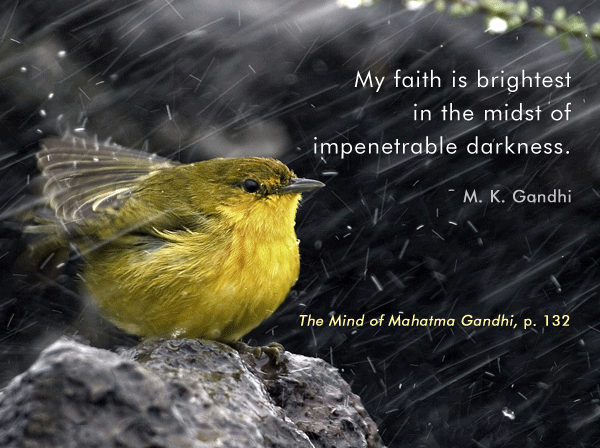Why Gandhiji fusses over the Cow?
Why Gandhiji fusses over the Cow?
(By Bharatan Kumarappa)
Once Smt. Aruna Asaf Ali raised a question which no doubt evoked sympathy in the minds of many. It was as to why we should trouble ourselves about the cow, when we have enough problems to tackle relating to man. Gandhiji’s brief reply was that if he bothered about the cow, it was because he saw that many problems relating to man in our country could not be solved except with reference to the cow. This answer deserve to be expanded and explained, if we are gain an understanding of the issue involve.
India is an agricultural country, with about 300 millions of its population depending on agriculture for their livelihood. For them the cow is more than their right hand, since without the aid of bullocks which the cow provides, ploughing, irrigating, weeding, harvesting, threshing, carting and marketing will be next to impossible. Bullocks are necessary for carrying on village industries like oil-pressing, At present these animals, which provide the motive power in agriculture and village industries, are weak, starved and diseased. How can people in our villages become prosperous so long as they have to depend on such a feeble instrument for eking out a livelihood ? The bullock is the villager’s machine. If a man is struggling with an inefficient machine which requires repairing and overhauling, who would say, "Why bother with the machine ? Help the man". The best way of helping him is to provide him with an efficient machine.
To this our city-educated youth may reply- "If the bullock is inefficient, scrap it, and use the tractor and other modern devices." The only difficulty about accepting this advice is that it is impracticable under present conditions. It is of no use telling us what should be done at some future date. We have to face the problems of our people today, and suggest means of improving their condition under present circumstance and within the resources now available to them. Which villager can afford a tractor and other modern agricultural machinery ? The bulk of them can hardly obtain a meal a day. It is like asking a clerk earning Rs.25/- a month to go to his office in a Rolls Royce. Marvelous idea, only it is unworkable. But it may be thought that though the average cultivator in India cannot afford tractors, a Zamindar can, and the peasant can use the Zamindar’s tractors. This, however, would mean, so far as the peasant goes, a condition ten times worse than at present, for at least now he is to a limited extent independent to till the soil as best as he can. But if he has to do away with his bullocks and use the Zamindar’s tractor he can do so only by becoming even more dependent than at present on the Zamindar for his instruments of production, and this means for him a step nearer to slavery. If, on the other hand, it is thought that peasants can pool their financial resources and by modern agricultural machinery co-operatively and use them co-operatively, then the difficulty is that today the co-operative movement is not being run by the villagers themselves, and the people have neither the capacity nor only in regard to the needed capital, but also in order to pool their land resources together, for their land is at present in tiny fragments, which are far too small for a tractor. Modern agricultural machinery is useful where there are hundreds of acres to be cultivated at a stretch. The peasant has very often only one or two acres in his ownership or control. To pool all these fragments together and to work them co-operatively is beyond his powers today.
Even later, it may not be wise for him to adopt tractors and mechanical devices in agriculture. They are useful in countries with a small population and vast areas to be cultivated. The situation in India is just the reverse. If we adopt machines to replace human beings in agriculture, where shall our people go for employment ? As it is, large scale industries are not able to absorb more than about two million and people are therefore even more increasingly being driven to agriculture for a live hood. But if agriculture also is mechanised, it too will not be able to provide work except for a few millions, and what is to happen to the rest of our 400 million people ?
Besides, mechanization involves fuel, of which we have only a limited supply in our country.
Further, it is said that artificial, manures like Chemicals, which we shall have to resort to, if in the place of bullocks we took to tractors and other machinery, are definitely injurious to the soil. They stimulate the soil and make it produce much for the time being, but only to leave it in the end exhausted and impoverished. They are also said to cause disease in crops and in animals. This is the experience of Sir Albert Howard, formerly Economic Botanist to the Govt. of India. He is definitely of the opinion, elaborated in his book called As Agricultural Testament that the only manure which can permanently enrich the soil and help healthy growth in plants and animals is organic, i.e. the cattle dung and urine, human excreta, and waste vegetable matter. If this is so, then cattle will be required in agriculture, not only for labour but also for the valuable manure they provide.
For these reasons, then it would seem best for us not to be allured into following the way of mechanised agriculture but to fall back on the bullock for motive power. If we do so, the cow which provides the bullock must occupy a central place in our national economy.
Consider further, many of us, whether for religious other reasons, are vegetarians, and do not wish to be a party slaughter of animals for food. Being vegetarians, we require milk and milk products to supplement the deficiencies of an exclusively vegetarian diet. We must therefore have some animals which will provide us milk. What is better than the cow, the mother of the bullock which we need for our agriculture? If we look after it well, it will provide us milk for our sustenance and bullocks for doing our work.
Instead of this, the modern tendency in India is to depend on the buffalo for milk. But the he-buffalo is comparatively useless for work in the fields. So it is slaughtered. Similarly, since the cow is wanted only for the sake of its bullocks, it is sent off to the slaughter-house no sooner then it has calved, and the calf has been weaned, for it is too expensive to feed the cow till its next calving. Thus under this method both the buffalo and the cow are slaughtered.
This can be avoided if we maintain only the cow, and obtain both our milk and our bullock from it. To do this will also be cheaper from the national view point, for we shall then have to maintain only one animal for both the purposes instead of two as at present.
Further, the bullock which we want from the cow will be stronger and of a better quality, for the cow will be better looked after and fed when we depend on it for milk.
Other reasons which may be given in favour of the cow for supply of milk as against the buffalo are(a) that cow’s milk is more conducive to health than buffalo’s as it has more vitamin B, and has in addition vitamin E which is absent in buffalo milk, (b) that the Carotene (vitamin A) value of cow’s ghee is ten times as high as that of buffalo ghee, (c) that the cow is less liable to disease than the buffalo, (d) that it matures a year earlier, (e) that its dry period, i.e. from the time it ceases to give milk to the time it calves again, is three times shorter than that of the buffalo, (f) that its milk yield is not affected adversely by heat and cold as the buffalo’s and (g) that the cow does not require as much grazing ground, feeding and water as the buffalo.
The deterioration in the cow and its bullock is precisely because we have departed from the old practice of looking to the cow as giver of plenty. Even with all its deterioration, the Indian cow, through centuries of careful breeding, is any day superior to its Western counterpart. The fat content of the milk of the Indian cow is rarely less than 4.5 per cent while British cows yield milk of 3.5 per cent fat content only. Besides, the Indian cow can live on lithe meager fodder locally available, can resist disease and withstand the tropical heat much better than the British cow. The solution therefore to the question of improving the present condition of our cattle is not to cross the local cow with foreign breeds which, as a matter of fact, has proved disastrous, for the mixed breeds cannot stand the poor feeding and the climate, nor can they provide us bullocks capable of doing hard work -but to restore the cow to the central place it once held, as the giver of milk and the mother of the bullock.
It is calculated that through its milk, bullocks, manure, hide and bone, the contribution of the cow to the wealth of India is over Rs. 1,000/- crores annually, an amount which no other industry in India except agriculture can be equal. Gandhiji has therefore established the Go Seva Sangh (association for looking after the cow ) to devote its attention on a countrywide scale to the improvement of the condition of cattle in India. Is Gandhiji wrong then to draw our attention to this most important national industry, and to show us the way to make it yield better results ?
Continues...





Comments